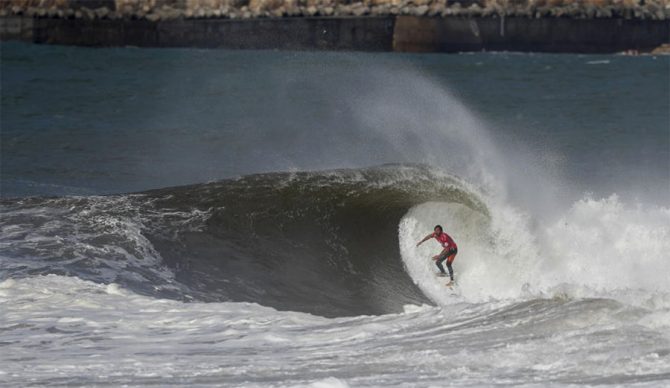
Except this guy. Jeremy Flores has been a solid rep for Europe for quite a while. Photo: WSL
As the European leg of the WCT ends, it’s hard not to reflect on the pitiful history of Euro representation at the top level of men’s competitive surfing. The list of successful European surfers is short and inglorious. To contextualize the impact European surfers have had on pro surfing you might put it like this: The Bronzed Aussies, The Momentum Generation, The Brazilian Storm, Jeremy Flores. In total, only eight European men have qualified to compete full-time in the elite ranks of professional surfing. (Technicalities such as Glenn Hall representing Ireland or Martin Potter for the UK don’t count, IMHO.)
Since its inception, professional surfing has been comprised almost entirely of Australians, Americans, and Brazilians. The Tour as we know it has existed since 1976, albeit overseen by three different governing bodies. But not until the year 2000 did the unlikely Russell Winter from Cornwall, UK became the first European competitive surfer to navigate the ‘QS grind and join the elite ASP Men’s Top 44.
Winter survived the Tour for 3 years, but he cut a lonely figure as the only European representation during this time. In 2003 when Winter had gone there were again no Europeans able to qualify. Eric Rebiere made a brief cameo for a single campaign in 2004, then the Tour again became a Euro free zone for the 2005 season, before Miky Picon qualified in 2006. Jeremy Flores became only the 4th European ever to qualify in 2007 and has at least been able to remain on Tour ever since.
Flores is by far and away the most successful European competition surfer (junior ranks and longboard divisions notwithstanding). He has finished in the top 10 in five of nine seasons, placing 8th in 2007 and 2015; 9th in 2010; and 10th in 2008 and 2012. Despite this he has never really come close to challenging for a title. As a rookie, he seemed destined to be a future world champ, but then surfing evolved and he didn’t. Flores remains competitive at most locations on Tour but now occupies the undesirable limbo of solid-but-unspectacular pro. He won’t be in World Title conversations, nor re-qualification battles, and he will always be a threat in heaving left reef breaks, but that’s pretty much all you can say.
Next in line to Flores and worthy of an honorable mention would be the Portuguese journeyman Tiago Pires. Despite never cracking the top 20, he did manage six consecutive seasons on Tour. As European surfers go this is somewhat of an achievement. Though most of us probably don’t miss watching his requalification death throes at the end of every season.
Aside from Flores and Pires, other European surfers that have qualified have been perennial bottom feeders. The names of Miky Picon, Marlon Lipke, Tim Boal and Aritz Aranburu don’t linger long in the memory, that is if you recognise them in the first place. Interestingly, all six of these surfers competed in the 2009 season. An anomaly which seemingly meant nothing and amounted to nothing. Very few of them ever saw the latter stages of an event, let alone strung together a record that granted them more than a single season on Tour.
Of course, this could all change next year with the arrivals of Leo Fioravanti and Joan Duru, both of whom have all but assured their places among the WSL elite men for the 2017 season. Duru might well fit the journeyman archetype, having finally qualified at 27 years old after 6 full seasons on the QS. It is highly likely that he will achieve nothing greater than a decent account of himself, and ultimately be one-and-done. Fioravanti, on the other hand, could be different.
As unlikely as it seems that a surfer from wave-starved Italy could make it in the pros, Leo Fioravanti appears to have potential. He’s young, hungry and generating hype. As Quiksilver’s new Golden Goose he’ll get all the backing he needs, and he’s already de-throned the king twice in 2016, knocking Slater out of Margaret River and France whilst competing as a wildcard. Given historical context, supporters of European surfing probably shouldn’t hold their collective breath quite yet. He’s far from guaranteed to break the mediocre European mold, but he’s certainly the most promising talent since Jeremy Flores.
However, the fact remains that in the context of world surfing, Europeans have been historically woeful. Actually, that’s being kind. Frankly, they’ve been an embarrassment. The reasons for lack of European success are somewhat of a mystery. Surfers from Europe have no obvious disadvantages. Europe is a wave-rich continent with a rich surf history, but for some reason it just doesn’t produce surfers able to represent this at the highest level.

